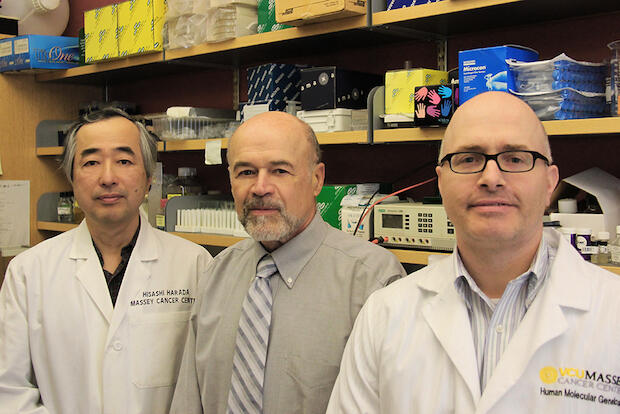
May 31, 2019
Massey scientists discover potential breakthrough in the understanding of tumor dormancy
Share this story
Scientists at VCU Massey Cancer Center may have uncovered a primary method through which cancer cells exist undetected in an organism and have received more than $1 million to investigate the potential for novel therapeutics that target and destroy cells in a specific state of tumor dormancy.
Cancer cells often migrate from the organ in which they originated and hide in a state of inactivity elsewhere in the body. These cells can reactivate at any time and pose a serious risk of recurrence and metastatic disease. The likelihood of curing cancer is greatly reduced once the disease has spread, and tumor dormancy remains one of the mysteries in the scientific understanding of cancer progression.
Ongoing research at Massey might provide new insight for novel cancer therapeutics by targeting cells in a particular state of inactivity called senescence.
“It is entirely unclear how tumor cells might survive in the body for months or years, only to break out of dormancy and give rise to recurrent disease,” said David Gewirtz, Ph.D., a member of the Developmental Therapeutics program at Massey and a professor of pharmacology and toxicology in the School of Medicine. “Our studies have suggested that one form of tumor dormancy might be that of senescence, a prolonged form of growth arrest that can be shown to be induced in tumor cells by chemotherapeutic drugs and radiation.”
Cellular senescence has long been understood as a DNA damage response in which normal cells cease to divide; however, its role in cancer cells is largely unknown. If dormant tumors are, in fact, in a state of senescence, Gewirtz said, it is possible they might be susceptible to elimination by senolytic agents —drugs that seek out and kill cells in a state of senescence.
Gewirtz is conducting the research along with Hisashi Harada, Ph.D., a member of the Cancer Cell Signaling program at Massey and associate professor in the Philips Institute for Oral Health Research in the School of Dentistry; and Joseph Landry, Ph.D., a member of the Cancer Molecular Genetics program at Massey and assistant professor of human and molecular genetics in the School of Medicine.
Research led by Gewirtz and recently published in Biochemical Pharmacology demonstrated that breast and lung cancer cells provoked into a state of senescence by chemotherapy were able to eventually recover and re-multiply at a rapid pace in culture and in mice. This finding challenged a commonly held notion about senescent cancer cells.
“The prevailing viewpoint for many years has been that senescence is an irreversible form of growth arrest,” Gewirtz said. “During the course of the last few years, the scientific community has come to accept that this is not necessarily the case and that cells can re-emerge from senescence and give rise to tumors, where the tumors are sometimes more aggressive than the original disease.”
If senescence is a form of tumor dormancy, then tumor cells that escape from senescence and survive will, in some cases, be the source of recurrent disease. Their elimination would provide a survival advantage for patients with cancer.
Based on these findings, Gewirtz published an article in Cancer Research suggesting that senescent cells are of significant importance in research seeking to understand how tumor cells evade existing therapies and hide in a state of dormancy, and to inform the development of novel cancer therapeutics.
“If senescence is a form of tumor dormancy, then tumor cells that escape from senescence and survive will, in some cases, be the source of recurrent disease. Their elimination would provide a survival advantage for patients with cancer,” Gewirtz said.
Gewirtz, Harada and Landry have received a five-year, $1.2 million grant from the National Cancer Institute to study whether senolytic drugs can effectively eliminate senescent-like lung tumor cells in order to prevent, or at least significantly suppress, cancer recurrence. They will test the ability of a particular drug to target and destroy cells in a senescent state, and seek to determine the specific role that genes that regulate cell death play in the destruction or preservation of dormant tumor cells.
It is unknown what role the immune system plays in sustaining therapy-induced tumor dormancy.
“The immune system has been known for some time to control the growth of tumors,” Landry said. “It is less clear how cancer therapies, and the senescence they induce, affect this natural response. They are likely to have complicated effects on the control of therapy-induced dormant cells.”
One goal of this study will be to establish the involvement of immune responses to tumor cell senescence caused by chemotherapy and radiation in the absence and presence of senolytic drugs.
“We also hope to establish a therapeutic strategy for the elimination of non-small cell lung cancer cells that have the potential to contribute to recurrent disease,” Gewirtz said.
Additional collaborators include Anthony Faber, Ph.D., co-leader of Massey’s Developmental Therapeutics program and assistant professor in the Philips Institute for Oral Health Research; Dipankar Bandyopadhyay, Ph.D., a member of Massey’s Cancer Prevention and Control program and professor of biostatistics at the School of Medicine; Xiang-Yang Wang, Ph.D., a member of Massey’s Cancer Molecular Genetics program and professor of human and molecular genetics in the School of Medicine; and Lynne Elmore, Ph.D., director of the Translational Cancer Research program of the American Cancer Society.
This research is supported in part by the Office of the Assistant Secretary of Defense for Health Affairs, the National Institutes of Health and VCU Massey Cancer Center’s National Cancer Institute Cancer Center Support Grant.
Subscribe to VCU News
Subscribe to VCU News at newsletter.vcu.edu and receive a selection of stories, videos, photos, news clips and event listings in your inbox.









